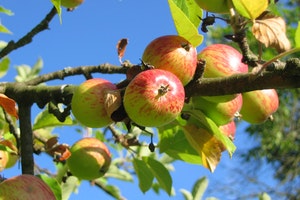Apples to apples: 400 years of genetic records cast new light on the parents of heritage varieties
12 September 2018

The humble apple may well be one of the most written about and important fruits in modern history, contributing to everything from the fabled discovery of the gravitational pull of the Earth, to its mythological status as a forbidden or magical fruit.
Now, a team from the University of Reading have been working at the National Fruit Collections to identify the parents of some of our best loved apples including the Ribston Pippin and Blenheim Orange, and have written their findings in PLOS One.
Apples have a genetic habit of sometimes adopting more than two sets of chromosomes, becoming a ‘triploid’. By comparing genetic similarities between various types of two chromosome (diploid) and three (triploid) apples, they noticed that it was possible to identify the historic apple varieties that had provided the extra sets of chromosomes that led to these popular triploids, many of which are still grown today.
Dr Matthew Ordidge from the University of Reading said:
“Apples have an interesting genetic habit in that they can have either two or three, or sometimes four, sets of chromosomes. By looking at their similarity we are able to spot the parental relationships where they swap from two to three.
“One of the most interesting findings is that, by looking at a measure of genetic similarity, we are able to identify the unknown parent of a number of the old triploid apples dating back to the 18th century, including the old English varieties Ribston Pippin and Blenheim Orange.”
The team noticed that triploid apples have often been selected because of their ability to produce large and good quality fruit. By understanding how some of the old triploids arose, Ordidge and his colleagues believe the findings will be useful for breeders trying to develop apples for the future.
Dr Ordidge continued:
“That knowing how some of the longest lasting and most popular triploid apples came about can only possibly be helpful to people trying to breed apples into the future.
“And that knowing a little more about the history of a series of apple cultivars that we have chosen to maintain, continue to grow, and occasionally attempt to document the history of, for around 300 years means that we understand the world in which we live a little better.”
Full reference: Ordidge M, Kirdwichai P, Baksh MF, Venison EP, Gibbings JG, et al. (2018) Genetic analysis of a major international collection of cultivated apple varieties reveals previously unknown historic heteroploid and inbred relationships. PLOS ONE 13(9): e0202405. https://doi.org/10.1371/journal.pone.0202405
